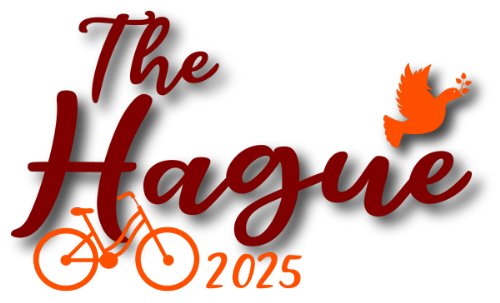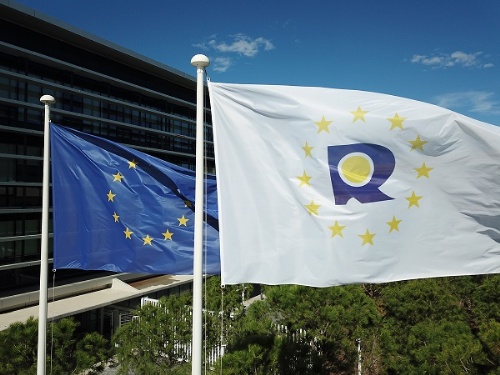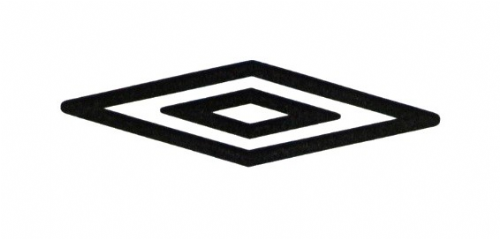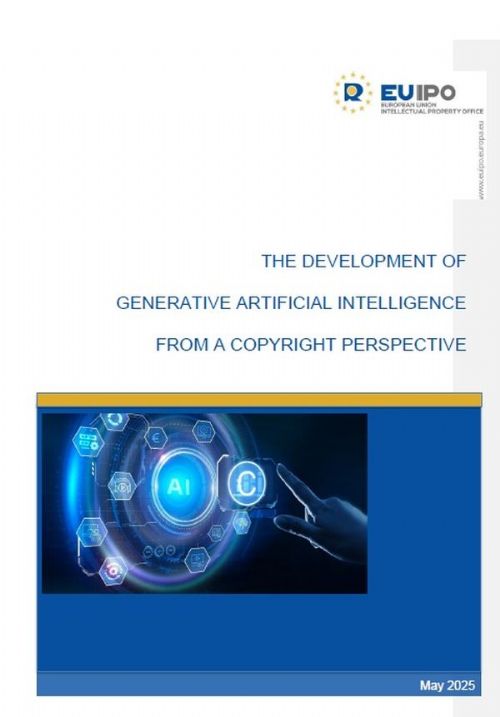Now in its twelfth year, Class 46 is dedicated to European trade mark law and practice. This weblog is written by a team of enthusiasts who want to spread the word and share their thoughts with others.
Click here subscribe for free.
Who we all are...
New podcast on the MARQUES Annual Conference
 Episode 25 of the Talking MARQUES podcast has just been published.
Episode 25 of the Talking MARQUES podcast has just been published.
This episode focuses on the 39th MARQUES Annual Conference, which takes place in The Hague, The Netherlands, from 16-19 September 2025.
The podcast features Willem Leppink, chair of The Hague Team; Liselott Enström, a member of the Team; and Dieuwerke van der Schalk, co-leader of the Corporate Task Force.
In the podcast, they discuss the attractions of The Hague as a host city; the highlights of the educational programme and workshops; the social events; the Corporate Breakfast for corporate members; and the key benefits of attending the Annual Conference.
They also answer some questions about the Annual Conference accommodation and travel in the Netherlands.
You can listen to the Talking MARQUES podcast on the MARQUES website here or on Spotify.
At the time of writing, 842 people from 79 countries have already booked for the Annual Conference.
Full information about the Annual Conference (including the programme and speakers, social activities, registration fees and accommodation details) is available on the MARQUES website here. You can also register online via this page.
MARQUES strongly recommends early registration for the Annual Conference to avoid disappointment.
Posted by: Blog Administrator @ 08.38Tags: Annual Conference, The Hague, Talking MARQUES,


 Sharing on Social Media? Use the link below...
Sharing on Social Media? Use the link below...Perm-A-Link: https://www.marques.org/blogs/class46?XID=BHA5367
EUIPO adds pre-assessment services to Easy Filing
 A set of pre-assessment services, some of them powered by AI, is now live in EUIPO’s Easy Filing application form for EUTMs.
A set of pre-assessment services, some of them powered by AI, is now live in EUIPO’s Easy Filing application form for EUTMs.
Easy Filing was launched in 2021 and is available for direct filers based in the European Economic Area, such as SMEs and individuals.
The pre-assessment services were previously available in the advanced EUTM filing form and provide real-time risk alerts and filing guidance. The services cover:
- Similar absolute grounds decisions (AI-powered)
- Earlier EUTM with an identical verbal denomination and at least one matching class of goods or services
- Conflicts with .eu domain names
- Conflicts with other IP rights such as registered geographical indications, traditional specialities guaranteed and traditional terms for wine or plant varieties
- Offensiveness, morality, public policy, or deceptiveness
EUIPO states: “If the system flags a potential issue, applicants can contact the EUIPO directly via the ‘Chat with us’ functionality, and seek connection with a local IP expert in their own language through the EUIPO’s Pro bono support service to remedy any hurdle on the road to registration. The results of the pre-assessment services however never replace the final decision taken by a human EUIPO examiner.”
Read more on EUIPO’s website here.
Posted by: Blog Administrator @ 11.24Tags: EUIPO, Easy Filing,


 Sharing on Social Media? Use the link below...
Sharing on Social Media? Use the link below...Perm-A-Link: https://www.marques.org/blogs/class46?XID=BHA5366
UK Supreme Court rules on post-sale confusion
 The UK Supreme Court recently published its judgment in Iconix Luxembourg Holdings SARL v Dream Pairs Europe Inc and another concerning two UK trade marks for the UMBRO double-diamond logo, registered for goods in class 25 and widely used on football boots (pictured right)
The UK Supreme Court recently published its judgment in Iconix Luxembourg Holdings SARL v Dream Pairs Europe Inc and another concerning two UK trade marks for the UMBRO double-diamond logo, registered for goods in class 25 and widely used on football boots (pictured right)
 Iconix, the trade mark owner, alleged that the Dream Pairs logo (DP sign, pictured left) as used on football boots sold in the UK was similar to the UMBRO marks and that its use was likely to cause confusion on the part of the public under section 10(2) of the Trade Marks Act 1994, and also infringed under section 10(3).
Iconix, the trade mark owner, alleged that the Dream Pairs logo (DP sign, pictured left) as used on football boots sold in the UK was similar to the UMBRO marks and that its use was likely to cause confusion on the part of the public under section 10(2) of the Trade Marks Act 1994, and also infringed under section 10(3).
The first instance judge found no infringement, saying there was “at most a very low degree of similarity”, but this finding was overturned on appeal: the Court of Appeal said that when the DP sign was viewed from any angle other than square-on, there was “a moderately high level of similarity”.
In its judgment on 24 June, the UK Supreme Court made the following findings:
- It rejected the submission (made by Dream Pairs) that extraneous circumstances such as how the goods are marketed or subsequently perceived are not to be taken into account in assessing similarity between the mark and the sign.
- It agreed with the Court of Appeal that “it is possible in an appropriate case for use of a sign to give rise to a likelihood of confusion as a result of post-sale confusion even if there is no likelihood of confusion at the point of sale”.
- It found that: “This was a case in which there were not matters such as irrationality, error of principle or of law which justified the Court of Appeal in substituting their own different view of the answer to the multifactorial question facing the judge from that which he had reached.” It added: “We would readily acknowledge that reasonable judicial views might differ on this issue about similarity when viewed from an angle, but our task is not to form our own view, unless both the judge and the Court of Appeal made what may loosely be called appealable errors.”
The Court’s ruling reinstates the first instance finding of no infringement.
Posted by: Blog Administrator @ 16.56Tags: UK Supreme Court, UMBRO, Iconix, post-sale confusion,


 Sharing on Social Media? Use the link below...
Sharing on Social Media? Use the link below...Perm-A-Link: https://www.marques.org/blogs/class46?XID=BHA5365
EUIPO and KIPO to hold public meeting next week
The EUIPO Boards of Appeal are holding an IP Tertulia with the Korean Boards of Appeal on Thursday 3 July 2025.
Topics to be covered include: the Korean trade mark and design appeal system, recent Korean case law on absolute and relative grounds, and recent EUIPO Boards of Appeal case law on absolute and relative grounds.
The event will feature speakers from the EUIPO Boards of Appeal and the Intellectual Property Trial and Appeal Board (IPTAB) of the Korean Intellectual Property Office (IPTAB):
- Mr Sven STÜRMANN, President of the EUIPO Boards of Appeal
- Ms JO Hyunjoo, Deputy director, Trial policy division, IPTAB
- Ms PARK Jaewon, Administrative trademark Judge of Board 13, IPTAB
- Ms Alejandra GONZÁLEZ FERNÁNDEZ, Member of the 1st Board, EUIPO Boards of Appeal
The Tertulia is being held in Alicante from 17:00 to 19:30 local time. However, online participation is also possible and the Tertulia is open to everyone.
You can register to join the event on the EUIPO website here, where you can choose whether to join online or in person.
There will be simultaneous translation between Korean and English.
Posted by: Blog Administrator @ 14.45Tags: EUIPO, KIPO,


 Sharing on Social Media? Use the link below...
Sharing on Social Media? Use the link below...Perm-A-Link: https://www.marques.org/blogs/class46?XID=BHA5364
Book now for MARQUES Annual Conference
 There is just one more week until the end of the Early Bird booking period for the MARQUES Annual Conference 2025, which will be held in The Hague, The Netherlands from 16 to 19 September.
There is just one more week until the end of the Early Bird booking period for the MARQUES Annual Conference 2025, which will be held in The Hague, The Netherlands from 16 to 19 September.
The Early Bird discount is available for full residential or non-residential packages booked by Friday 27 June.
The theme of this year’s Conference is “Brand Changes in an International Context”. Sessions will cover a wide range of topics including: the impact of external factors on IP work; brands in international trade; the rise of sustainability; international jurisdiction in trademark litigation; brands in international M&A; brand revivals; and the latest CJEU and EU General Court case law.
There will also be seven workshops and the opportunity to join a visit to Europol headquarters.
The social programme includes: Welcome Reception at the World Forum on 16 September; Cultural Evening at Madurodam on 17 September; and Gala Dinner Evening in De Broodfabriek on 18 September.
This year, you can choose your hotel when booking (subject to availability). The four conference hotels are the Novotel, Leonardo, Marriott and Hilton.
The Early Bird rate for MARQUES members is €3,100 (fully residential package) or €2,545 (full programme excluding accommodation).
The Early Bird rate for non-members is €3,950 (full residential package) or €3,395 (full programme excluding accommodation).
Find out more about the Annual Conference on the dedicated page on the MARQUES website. This page includes links to: the programme; accommodation details; tours/excursions; registration fees; terms and conditions; getting there; and sponsors; and online registration.
As of 19 June, 568 people form 70 countries had already booked their place at the Annual Conference.
Posted by: Blog Administrator @ 08.25Tags: Annual Conference, The Hague,


 Sharing on Social Media? Use the link below...
Sharing on Social Media? Use the link below...Perm-A-Link: https://www.marques.org/blogs/class46?XID=BHA5363
EUIPO’s study on GenAI and copyright
 On 12 May 2025, the EUIPO released a detailed study analysing how generative AI (GenAI) impacts EU copyright law. Gabriele Engels, Chair of the MARQUES Cyberspace Team, explains more.
On 12 May 2025, the EUIPO released a detailed study analysing how generative AI (GenAI) impacts EU copyright law. Gabriele Engels, Chair of the MARQUES Cyberspace Team, explains more.
The study focuses on three areas: the use of copyrighted content as training data by GenAI models (GenAI input), the legal status of AI-generated content (GenAI output) and the broader implications for rights holders, AI developers and the copyright ecosystem.
Although designed for legal experts and policymakers, the findings are significant for tech companies, creators, platforms and rights holders. As companies adopt GenAI on a growing scale, legal and commercial questions around data use, authorship, licensing and enforcement are in urgent need of clear answers.
To help these stakeholders, EUIPO plans to launch a Copyright Knowledge Centre in November 2025, aimed at supporting rights holders to manage the use of their works, inform EU policymakers and tackling key challenges.
GenAI inputs
AI models need vast amounts of data to train their algorithms. This is often collected through web crawling or scraping practices that may involve copyright-protected material. As a result, many of the measures used by copyright holders to control access to their works focus on combating this practice.
Legal background
Under the EU’s Copyright in the Digital Single Market Directive (DSM Directive), text and data mining (TDM), which is the reproduction of content for training purposes, is allowed in specific circumstances.
In this context, Article 4 of the DSM Directive provides for the rights holders ability to “opt out” of TDM by clearly stating their objection, and thereby reserving their exclusive copyrights. For this opt out to be valid, the reservation must be made expressly, by the rights holder and in an appropriate manner, including “machine-readable means” for content made publicly available online. In case of such an opt out, developers must obtain an authorisation by the right holder, usually a licence agreement, before using the content.
The EU’s Artificial Intelligence Act (EU AI Act) adds that GenAI providers must respect TDM opt-outs by copyright holders and disclose sufficiently detailed summaries of the training data they utilise. It also requires AI-generated content to be detectable in a machine-readable format.
Rights reservations
| "There is a consensus amongst stakeholders that REP doesn’t meet the DSM-Directive’s standards for expressing copyright opt-outs in an appropriate manner." |
Robots Exclusion Protocol (REP) is a technical tool that website owners use to express their rights reservations and manage web crawling and scraping activities. However, there is a consensus amongst stakeholders that REP doesn’t meet the DSM-Directive’s standards for expressing copyright opt-outs in an appropriate manner.
It is seen as an incomplete and temporary solution due to its voluntary nature: it has to be complied with by scrapers, which undermines its enforceability as a technical safeguard.
A widely acknowledged limitation is REP’s inherent lack of granularity and specificity regarding permitted uses. It requires website managers to actively configure and maintain restrictions, making implementation inconsistent across different sites.
No opt-out standard
No opt-out mechanism has emerged as a standard for rights holders to express their TDM rights reservations. Copyright holders use a mix of various legal measures (unilateral declarations, licensing constraints, website terms and conditions) and technical measures (metadata and content provenance protocols).
Legally driven measures are typically applied to specific copyright-protected works, but also entire repertoires of works. Technically driven measures are categorised as either location-based (i.e. applied to a specific copy of a digital asset as hosted in a particular location) or asset-based (i.e. applied to the digital asset more broadly and replicated in every copy of that asset).
Both approaches have their distinct advantages and limitations and rights owners often use a combination of measures.
However, these methods appear to give rights owners only the possibility to express their rights and not to enforce them. AI developers are responsible for respecting these choices and configure their tools accordingly. The study anticipates the development of sector-specific standard practices.
GenAI outputs
The study further explores legal concerns around AI-generated content, noting that output depends on the type of GenAI model and content type created. New tools such as watermarking and digital fingerprinting are helping identify synthetic content produced by GenAI systems and meet transparency requirements under the EU AI Act.
Standard technologies
| "While RAG boosts the relevance and efficiency of the data drawn, it introduces legal uncertainty, especially around licensing and database rights, since it differs from traditional training covered by TDM rules." |
There is a trend of increased deployment of Retrieval-Augmented Generation (RAG) technologies that combine GenAI with real-time data retrieval, often from copyrighted sources.
While RAG boosts the relevance and efficiency of the data drawn, it introduces legal uncertainty, especially around licensing and database rights, since it differs from traditional training covered by TDM rules. This is particularly the case if dynamic content is read via web scraping.
Technical and legal measures
Developers are adopting technical fixes to reduce the risk of copyright infringement in AI-generated content. These include:
- Tools for comparing generated content with potential input sources
- Filters to prevent duplicate outputs
- Prompt rewriting and negative prompting
- Differential privacy to prevent models from memorizing data
- Post-training tools such as “model editing” and “model unlearning” to remove or alter specific content
Prompt rewriting changes user inputs to prevent generating near duplicate outputs, while negative prompting also specifies to the model which elements should be excluded from the generation, such as key features associated with copyright-protected characters.
Some providers even offer some form of legal indemnification to users, reflecting the growing awareness of potential legal risks.
In this context it is noted that public bodies can help to mitigate potential infringing outputs and detect synthetic content by providing technical support and raising awareness on technical standards, promoting ethical AI use and support the interoperability of output transparency measures across platforms and GenAI systems. A joint approach – legal, technical, and institutional – is key to managing the risks of GenAI output.
Evolving direct licensing market
| "A functioning licensing system requires strong opt-out mechanisms, which can provide new income streams for rights holders." |
The study identifies a new market which is forming for direct licensing of copyright-protected content for AI training, driven by demand for high-quality datasets and concerns over future data availability. Press, scientific and academic publishing are early movers.
This market is enabled by the Article 4 DSM Directive opt-out mechanism, making it a copyright infringement for AI developers to use opted-out works that may be available for license.
A functioning licensing system requires strong opt-out mechanisms, which can provide new income streams for rights holders. This also creates a market for technical solutions for managing access to content (particularly in online settings) and administering TDM rights reservations.
The study further lists several key considerations that may affect the evolution of licensing practices. They will depend on benchmark market rates, metrics used for remuneration, legal frameworks for remuneration and compensation models.
Conclusion
Navigating the interaction of GenAI and copyright will require coordinated and forward-looking action. The study calls for technical standards, policy tools and collaboration to keep copyright law able to address the implications of large-scale AI adoption.
Institutions such as the EUIPO can support this through guidance, databases, and awareness initiatives.
The upcoming Copyright Knowledge Centre is a step toward that goal, but long-term success depends on continued cooperation among GenAI developers, policymakers and rights holders, in order to (re-)establish a balance between the creative and IT industries.
Gabriele Engels is a Partner with D Young & Co in Munich and Chair of the MARQUES Cyberspace Team
Posted by: Blog Administrator @ 09.35Tags: GenAi, copoyright, EUIPO, Cyberspace,


 Sharing on Social Media? Use the link below...
Sharing on Social Media? Use the link below...Perm-A-Link: https://www.marques.org/blogs/class46?XID=BHA5362
The Madrid System in 2024
 WIPO has published the Madrid System Yearly Review, which includes facts and figures on use of the System in 2024.
WIPO has published the Madrid System Yearly Review, which includes facts and figures on use of the System in 2024.
Key points are:
- About 65,000 international trademark applications were filed during the year (+1.2%) and about 452,889 designations (+1.1%)
- A total of 915,034 international trademark registrations were in force (+2.7%) with 7,325,670 designations
- For the fourth consecutive year, the UK received the most designations (28,877)
- The US topped the list of users, with US applicants filing 11,270 international applications (+2.5%) followed by those from Germany (6,449) and China (5,828)
- For the fourth year in a row, L’Oréal was the top filer (244 applications) followed by Novartis (193) and Euro Games Technology (141)
- Class 9 accounted for 10.8% of all classes of goods and services specified in applications. Classes 35, 42 and 41 were also very popular
Read more on WIPO’s website, from where the image is taken. The Madrid Yearly Review 2025 is available to download in English as a PDF and the data can be downloaded in XLS format.
Posted by: Blog Administrator @ 11.55Tags: Madrid Yearly Review, WIPO, ,


 Sharing on Social Media? Use the link below...
Sharing on Social Media? Use the link below...Perm-A-Link: https://www.marques.org/blogs/class46?XID=BHA5361

